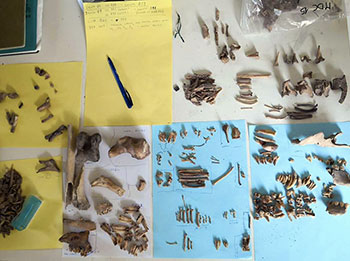Study Zooarchaeology

Why study animal bones?


To accomplish this, our one week course will combine theory lectures and direct laboratory practice on newly excavated material, covering basic notions of anatomical identification, zoological taxonomy, familiarisation with the fauna of ancient Roman Campania and quantitative and qualitative analysis of bone data. Taphonomy will be discussed, both as a post-depositional phenomenon and as a consequence of human intervention, dealing with burn and cooking marks, different kinds of cut-marks, fragmentation and other physical traces on the bones. The basics of estimations of number of individuals, the consumable weight and the allometric variations will be discussed.
Most importantly, we aim to connect these theoretical and practical facets of Zooarchaeology to the site of Pollena Trocchia, presenting what this specialisation can tell us about the bath complex and its connection with the villa, and how the animal assemblage can be linked with other kinds of evidence and be used to pose new questions about the relationship between our site and the others in Campania at the time of the later Vesuvian eruption.
Specific research questions
The Apolline Project aims to study the commercial connections between sites in Campania, the neighbouring regions, and the wider Mediterranean basin through all kinds of archaeological evidence. Within this frame, the animal remains are used to characterise the alimentary patterns in the later Roman Empire and the regional organisation and interconnection of food production. We argue that there is evidence proving that the production network operated both at regional and interregional levels and that the Pompeian eruption of Mount Vesuvius deeply affected the production and distribution routes. Zooarchaeology can indeed provide instances of the crisis periods and the subsequent transformations occurred in the economic networks.

Lastly, on a smaller scale, the faunal evidence from Pollena Trocchia can help clarify the micro-history of the site, as for example by assessing whether each room was still in use or abandoned at a specific timeframe. This approach proved already extremely useful to specify theories, test the evidence from the artefacts, and open the research to new questions on the wider landscape.
To know more about the results achieved so far:
A. De Luca, G.F. De Simone, "Dati archeozoologici da Pollena Trocchia e alcune considerazioni sull'alimentazione nella Campania tardo antica", Rivista di Studi Pompeiani 23 (2012), 159-162 [ISBN: 978-88-8265-773-4]
Taking part
The class will take place from the 12th to the 16th of August 2019, at the cost of 350 EUR. To apply, please go to this page.
The final deadline for applications is June 20th and those who apply will find out if they have been successful within three weeks of their application as acceptances to the program are rolling. Please consider that places are very limited, therefore we encourage you to submit your application earlier rather than later.
Application process
The application process is easy and straightforward. Please follow this link and complete the electronic application.
Nota Bene: if you have landed directly in this webpage, you might want to take a look at our other activities here.
